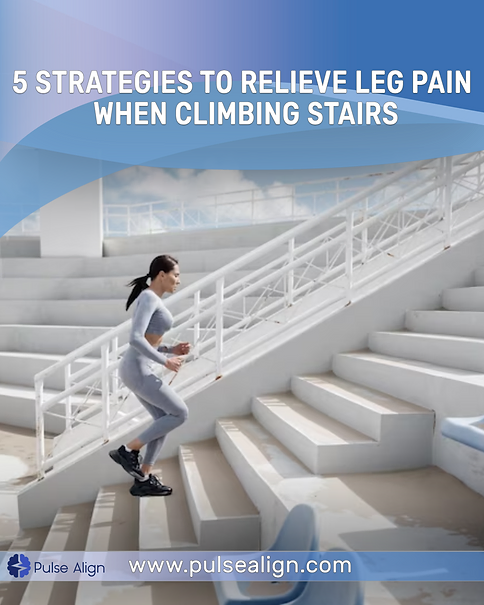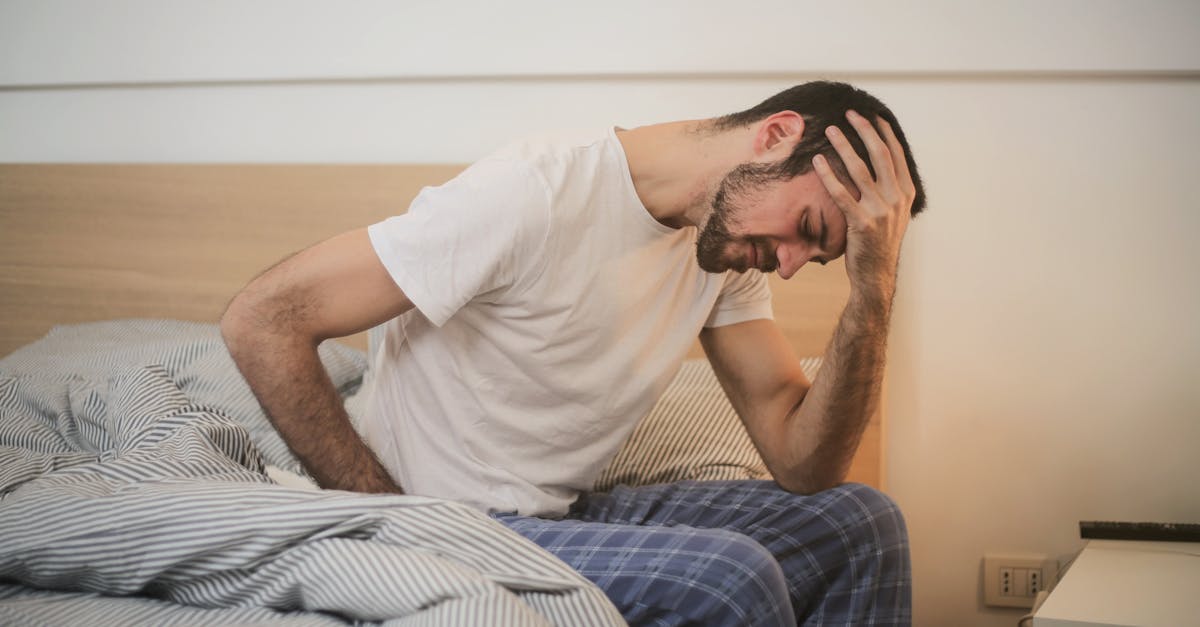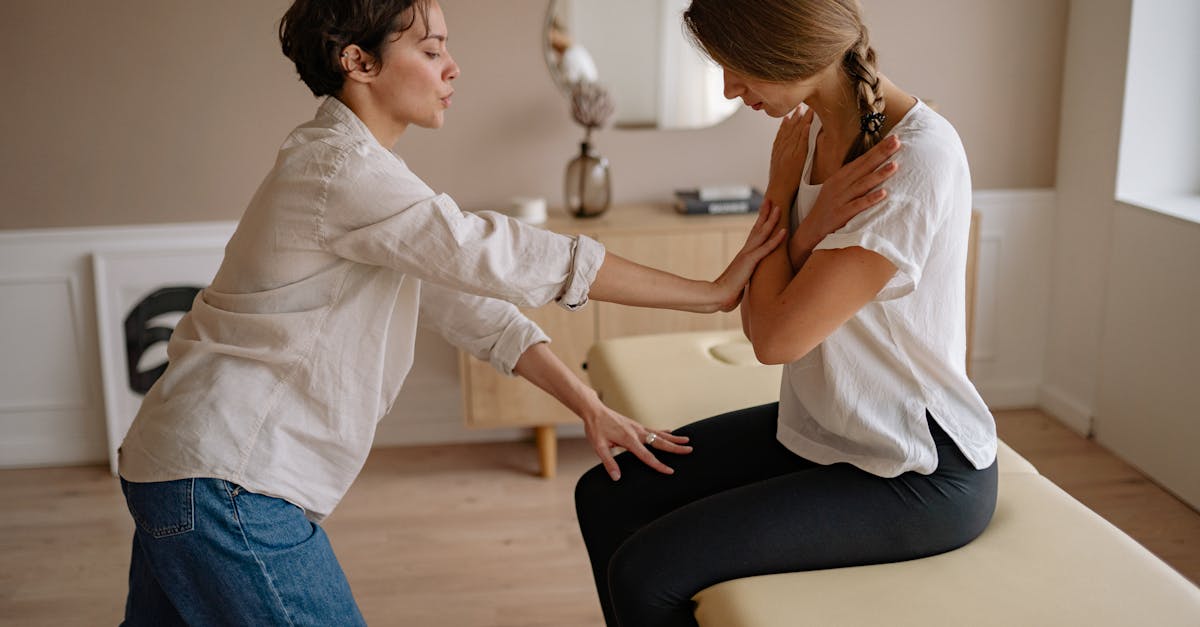Are you experiencing leg pain when climbing stairs? You’re not alone. Many individuals encounter discomfort and pain while ascending or descending stairs, which can significantly impact their daily lives and mobility. Whether your leg pain stems from muscle fatigue, joint issues, or other underlying conditions, finding relief is essential for maintaining a healthy and active lifestyle.
Leg pain is a prevalent musculoskeletal issue, with an average point prevalence of 8.2% among adults globally. In the United States (US), approximately 28% of adults experience LBP within three months.
In this blog, we’ll explore five effective strategies to alleviate leg pain when climbing stairs while emphasizing the importance of addressing root causes and considering holistic approaches such as Pulse Align for improved well-being.
Understanding Leg Pain When Climbing Stairs
Leg pain when climbing stairs can result from various factors, including muscle strain, joint inflammation, tendonitis, or underlying health conditions such as arthritis or peripheral vascular disease. Additionally, poor biomechanics, improper footwear, overuse injuries, or muscular imbalances may contribute to discomfort during stair climbing.
For many individuals, stair climbing is a routine activity that becomes challenging and painful when leg discomfort arises. However, by implementing targeted strategies and lifestyle modifications, it’s possible to alleviate pain and improve stair-climbing comfort and mobility.
Strategies to Alleviate Leg Pain When Climbing Stairs
Proper Warm-up and Stretching Routine
Before tackling a flight of stairs, it’s crucial to prepare your muscles and joints with a proper warm-up and stretching routine. Dynamic stretches that engage the muscles and joints involved in stair climbing can help improve flexibility, reduce stiffness, and minimize the risk of injury.
Focus on stretches that target the quadriceps, hamstrings, calves, and hip flexors. Incorporating exercises such as leg swings, lunges, and calf stretches can enhance muscle elasticity and range of motion, making stair climbing more comfortable and efficient.
Strengthening Exercises for Leg Muscles
Weakness in the muscles supporting the legs and knees can exacerbate pain and discomfort during stair climbing. Implementing a targeted strength training program can help improve muscle endurance, stability, and joint alignment, reducing strain and stress on the lower extremities.
Exercises such as squats, lunges, calf raises, and leg presses can strengthen the quadriceps, hamstrings, calves, and glutes, enhancing overall lower body strength and stability. Gradually increase resistance and repetitions to progressively challenge your muscles and improve functional capacity.
Optimize Footwear and Biomechanics
The footwear you choose can significantly impact your comfort and stability while climbing stairs. Invest in supportive shoes with adequate cushioning and arch support to reduce impact and provide optimal shock absorption during stair ascent and descent.
Additionally, pay attention to your biomechanics and posture while climbing stairs. Maintain a tall posture with your shoulders relaxed and your core engaged. Avoid excessive leaning forward or backward, and focus on distributing your weight evenly between both legs to minimize stress on the knees and ankles.
Consider Pain Management Strategies
If you experience persistent or severe leg pain when climbing stairs, consider incorporating pain management strategies to alleviate discomfort and improve mobility. Over-the-counter pain relievers such as ibuprofen or acetaminophen can help reduce inflammation and alleviate pain associated with stair climbing.
Furthermore, topical analgesic creams or gels containing ingredients such as menthol or capsaicin can provide temporary relief by numbing the affected area and reducing sensations of pain and discomfort.
Address Underlying Causes with Holistic Approaches
While symptomatic relief is essential, addressing the root causes of leg pain when climbing stairs is paramount for long-term improvement and well-being. Holistic approaches such as Pulse Align focus on restoring balance and function to the body’s natural systems, addressing underlying imbalances and dysfunctions that contribute to pain and discomfort.
Pulse Align emphasizes the importance of considering the interconnectedness of the body and addressing the underlying causes of symptoms rather than merely masking them. By promoting optimal alignment, mobility, and circulation, Pulse Align aims to support the body’s innate ability to heal and function optimally, leading to improved overall well-being and quality of life.
The Benefits of Pulse Align for Leg Pain When Climbing Stairs
Pulse Align offers a comprehensive approach to addressing leg pain when climbing stairs by targeting the root causes of discomfort and promoting natural healing processes. By optimizing spinal alignment, enhancing nervous system function, and improving circulation, Pulse Align aims to alleviate pain, restore mobility, and enhance overall well-being.
Research studies have shown that holistic approaches like Pulse Align can complement traditional treatment modalities and contribute to better outcomes for individuals experiencing musculoskeletal discomfort and pain. However, it’s essential to consult with a qualified healthcare professional to determine the most appropriate treatment approach for your specific needs and circumstances.
Conclusion: Embracing Holistic Wellness for Improved Well-Being
In conclusion, leg pain when climbing stairs can significantly impact your daily life and mobility, but effective strategies and holistic approaches can help alleviate discomfort and promote long-term well-being. By incorporating proper warm-up and stretching routines, strength training exercises, optimizing footwear and biomechanics, and considering holistic approaches like Pulse Align, you can find relief and enhance your quality of life.
Remember, achieving optimal health and wellness is a journey that requires commitment, patience, and a willingness to explore various treatment options. By addressing underlying imbalances and promoting natural healing processes, you can experience improved mobility, reduced pain, and enhanced overall well-being.
Are you ready to take the first step towards a healthier, pain-free lifestyle? Consider exploring holistic approaches like Pulse Align and incorporating lifestyle changes to support your journey to improved well-being and vitality. Your body deserves to thrive, and embracing holistic wellness can help you achieve a natural return to normal function and vitality.
References:
Amabile, A. H., Larson, S. L., Hoglund, L. T., Guarnieri, J. P., McDonald, M., & Reich, M. R. (2023). A greater number of weekly stairs climbed is associated with lower low back pain prevalence among female but not male physical therapists. Plos one, 18(10), e0292489.https://journals.plos.org/plosone/article?id=10.1371/journal.pone.0292489
As the visionary CEO of Pulse Align, François is dedicated to transforming the landscape of pain management and posture health. With a deep-rooted passion for innovation and a commitment to excellence, François leads the team in developing cutting-edge solutions that empower individuals to live healthier, pain-free lives. Under his leadership, Pulse Align has become a beacon of hope and support for those navigating postural-related issues and chronic pain. François brings a wealth of experience in neuromodulation and patient management technologies, combining strategic insight with a compassionate approach to address the unique challenges faced by each individual.




